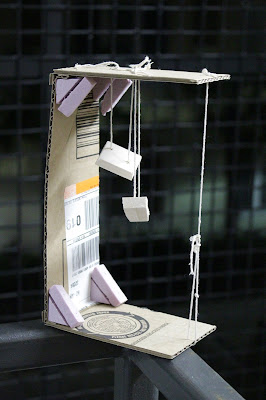Suspension
by Korey Nelson
In the chapter dedicated to touch, Ackerman focuses her attention on many standard experiences regarding the sensation and deconstructs the mechanics of touch. The text is filled with inordinately descriptive language and often finds itself wandering through tangents filled with anecdotal tales and historical trivia. One such tangent mentioned Helen Keller and her keen sense of touch in the absence of her sight and hearing. Ackerman later provokes the thought of losing the sense of touch and citing a few instances in which individuals lost the ability to identify an object like keys simply by feeling.
Suspension is a metaphor for the effect one gets when they temporarily lose the feeling in their legs, as when one is intoxicated or ill and feels a distinct flotation when walking. The separate pieces of wood dangling from their housing represent the disconnection of the body from the mind and create a swinging motion when placed outside. The cardboard housing is representative of the world's rigid and enveloping environment, contrasting the free-floating nature of the body and mind; a landscape for the individual to traverse. The tightly wound string symbolizes the tension and sensitivity in this metaphoric environment and works to evoke a sense of stress in the viewer; an element contrasting the free-willed nature of the two wooden chunks, free to swing in the wind as they wish.
Pulp
by Korey Nelson
The concept for this sculpture was inspired by the chapter titled "Synesthesia," more specifically, from the premise that the humans experience sensation in spectrum and multiples. Unless deliberately deprived of a sensation, all our senses are acting at once and often crossover and merge with other senses. Separating sensation into individual categories will not accurately represent our experience, and so while synesthesia is in a few individuals a phenomenon, the mentality when approaching sensation should be devoid of separation.
In making Pulp, I tried to create an environment in which one can take this mentality and apply it freely. The sculpture was designed to trigger a sour taste, a bitter smell, a distinct sticky feeling between the fingers, a messy and unnerving sight, an uncomfortable squishing as the wet hand runs its way through the fruit's soft flesh. A coarse, dark pit sits in the middle of the squashed globe as if a prize for my discomfort. The sculpture is currently on display on the 5th floor of the Flagler FEC Parking Garage to the North-West of the staircase and elevator shaft.














































Comments
Post a Comment